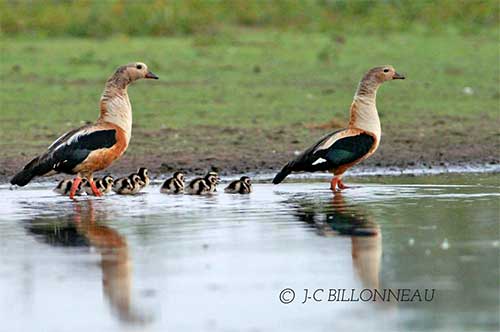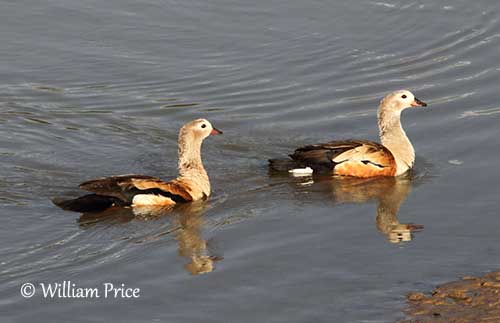
PROTECTION / THREATS / STATUS:
The Orinoco Goose is threatened by heavy, continuing hunting pressure that is the primary reason for the population decline. However, conversion of wetlands for rice production and agriculture expansion reduce the suitable habitat required by this species. But the Orinoco Goose is present in several private and public protected areas.
The global population is roughly estimated to number 10,000/25,000 mature individuals, and is suspected to be declining slowly.
The Orinoco Goose is currently classified as Near Threatened.
Fr: Ouette de l'Orénoque
Ang: Orinoco Goose
All: Orinokogans
Esp: Ganso del Orinoco
Ita: Oca dell'Orinoco
Nd: Orinocogans
Sd: orinocogås
Photographers:
Roger Ahlman
Pbase Galleries Peru and Ecuador
Jean-Claude Billonneau
Photographe-témoin de la Beauté du Monde
William Price
PBase-tereksandpiper & Flickr William Price
Text by Nicole Bouglouan
Sources:
HANDBOOK OF THE BIRDS OF THE WORLD vol 1 by Josep del Hoyo-Andrew Elliot-Jordi Sargatal - Lynx Edicions - ISBN: 8487334105
GUIDE DES CANARDS, DES OIES ET DES CYGNES – de Steve Madge - Delachaux et Niestlé - ISBN: 2603013769
A GUIDE TO THE BIRDS OF COLOMBIA by Steven L. Hilty and William L. Brown - Princeton University Press – ISBN 069108372X
Neotropical Birds – Cornell Lab of Ornithology
Wikipedia, the free encyclopaedia
American Bird Conservancy – ORINOCO GOOSE
RAINFOREST Expeditions Orinoco Goose
Zoo New England – Orinoco Goose
ENDEMIC WILDLIFE FOUNDATION - ¡COLOMBIA ALIVE!
Orinoco Goose
Neochen jubata
Anseriformes Order – Anatidae Family
INTRODUCTION:
The Orinoco Goose is found in northern South America E of Andes where it is widespread throughout the range. This goose is very terrestrial and is often seen perched in small trees, rather than flying or swimming. It mainly frequents rivers, streams and lakes bordered by forest, wooded islands, wet savannas and edges of freshwater wetlands. It feeds on aquatic plants and seeds, and also consumes insects and crustaceans.
The Orinoco Goose is threatened by heavy hunting pressure and changes in the habitat for agriculture expansion. The species is currently Near Threatened.
DESCRIPTION OF THE BIRD:
Biometrics:
Length: 61-66 cm
Weight: M: 1700-1950 g – F: 1200-1440 g
The Orinoco Goose has pale creamy-buff head, neck and centre of breast. Rest of plumage is mostly chestnut, becoming dark green on lower back and tail. The upperwing is dark green with a broad white band across the secondaries. This feature is well visible in flight. The speculum is glossy green.
On the chestnut underparts, the undertail-coverts are white.
The two-tone bill has black upper mandible and reddish lower mandible. The eyes are dark brown. Strong legs and feet are reddish.

Male and female have similar plumage, but the female is slightly smaller than male. Her neck feathers appear shorter and paler.
The juvenile is a duller version of the adults. It has buff underparts, wings and tail are not glossy, legs and bill are paler and duller.
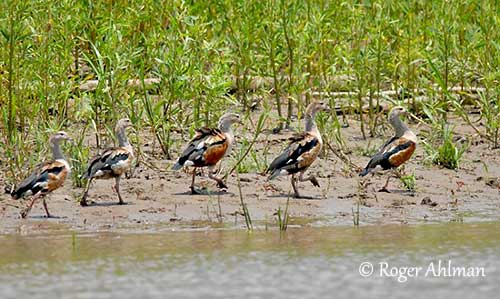
RANGE:
The Orinoco Goose is found in N South America E of Andes from E Colombia, Venezuela and the Guianas, S through Amazonian Brazil, E Ecuador, E Peru, E and S Bolivia and W Paraguay to extreme NW Argentina (Salta).
HABITAT:
The Orinoco Goose frequents the sides of tropical rivers with forest and rocky or sandy beaches, wet savannas, wooded islands, and muddy and sandy shores of freshwater wetlands. It usually occurs at low elevation up to 500 metres. However, the species is sometimes recorded up to 2,600 metres of elevation in Colombia.
CALLS AND SONGS: SOUNDS BY XENO-CANTO
The Orinoco Goose is noisy. The male gives a high whistle and loud guttural honking during the breeding season. It utters a shrill-whistled “zree” and also several thin, high whistles.
The female produces a loud cackle. Her honking is described as “gu-rump, gur-rump, gur-rump”.
Both male and female give another nasal honking “unnhh?”. The pair may duet when perched.
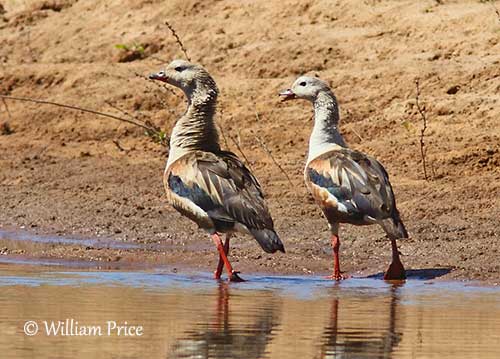
BEHAVIOUR IN THE WILD:
The Orinoco Goose feeds on aquatic plants, sedges, terrestrial grasses, and may occasionally take worms, insects, crustaceans and molluscs. It consumes both seeds and leaves of several plant species found in beaches. It also feeds on aquatic algae in stagnant water along rivers or in pools.
It forages by walking along the forested riverbanks and edges of large wetlands. The strong legs and webbed feet allow the bird to forage on the muddy ground in the rainforest. Unlike most ducks and geese, this species is rarely seen floating in the water or flying, but it happens sometimes. When an adult is with flightless chicks, it escapes a danger by entering the water.
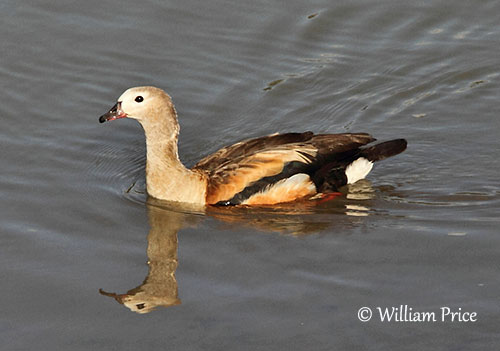
The Orinoco Goose has strong pair bond, and both mates may remain together for several years. They are territorial during the nesting period, and the male becomes aggressive against intruders while defending both female and territory.
Some courtship displays include ruffled feathers, raised wings, mutual preening and repeated vocalizations.
The Orinoco Goose is often seen in pairs or in family groups. The male takes part in guarding the chicks after hatching, but the female incubates alone.
This species is mainly sedentary throughout the range, and only performs small movements. However, the migratory behaviour in Amazon Basin could be more widespread than previously thought.
The Orinoco Goose rarely flies or swims, preferring to perch in small trees. But while flying, the wings produce a kind of rattling noise.
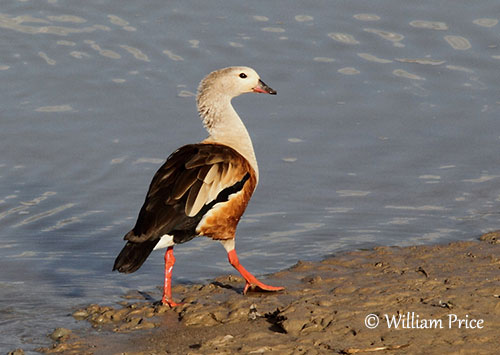
REPRODUCTION OF THIS SPECIES:
The Orinoco Goose breeds during the dry season, usually in December/January in Colombia and Venezuela. But the breeding season may vary slightly throughout the wide range.
It nests in single, well-spaced pairs. The nest is often placed in hollow or other cavity such as limb loss or wood rot. It is placed at about 3 metres height and close to the water. The cavity is usually lined with whitish down. This species also uses nest-boxes when available.
The female lays 6-10 pale brownish to creamy eggs. She incubates during 28-30 days to 32-34 days while the male remains in the vicinity of the nest.
At hatching, the chicks are black with white markings on the upperparts, whereas the underparts are white. We can see a blackish spot on ear-coverts, narrow dark bands on sides and hind neck, and broad white bands on wings and back.
The chicks are cared by both parents and the male strongly defends both family and territory against intruders and predators by charging towards any threat. The fledging period is unknown.
